It’s already been lost to collective oblivion, but there were moments there – such as when the present prime minister tried to prorogue parliament, for instance; or when Michael Howard menaced Spain with threats of war over the rock – that I had trouble sleeping, so it’s hardly surprising I found some consolation when I read that Pope Francis was embroiled in a controversy over pagan idols. ‘Ha, those crazy papists,’ I thought, ‘whatever will they find to hyperventilate over next?’ It’s a sure sign that your country has taken leave both of its senses and its self-respect, indeed that it has abandoned all claims to dignity on the world stage, when you have to resort to controversies in the Vatican for more ridiculous examples.
It all began in the grounds of the Vatican during a prayer service. The Guardian reported that, on the eve of the Synod of Bishops for the Amazon, something outrageous appeared at what was an otherwise innocuous picnic.

But if it sounds a tad intemperate, you should read the reaction of George Neumeyr in the American Spectator, which, frankly, made the cardinal sound like a bit of a wuss. Neumeyr is no mincer of words. He calls his Holiness a ‘dilettantish modern Jesuit’ (mee-ow) and the ‘first non-Christian pope.’ Let’s pause to digest that charge, shall we. It amounts to saying that, contrary to appearances, not only is this new-fangled pope not a Catholic; he is not even, according to the definition by Merriam-Webster, one who ‘professes belief in the teachings of Jesus Christ.’
If the plot of ‘The Two Popes’ is to be believed, then Benedict made a big mistake inviting Bergoglio over to Rome, thinking he was going to present his resignation letter, and then resigning before Bergoglio got the chance. A bi-i-i-g mistake, as he let the Antichrist in, something popes have tried to avoid doing for centuries, allegedly. At least, so some of his supporters (and they have the lousy T-shirts to prove it) strongly believe.

Readers who saw my first piece entitled Of Cannibals may be feeling perplexed at this point. Wasn’t the whole point about Pachamama that, as long ago as the seventeenth century, she and her guinea pig sidekick had been accepted parts of every good Andean Catholic’s repertoire? I mean, syncretism, it’s the way to go right?
Wrong. Mr Neumeyr continues,
‘Day after day during the synod, the faith has taken a battering, as clerics lecture Catholics on the virtues of syncretism, a mindless multiculturalism that extols Amazonian women who breastfeed animals…’
That’ll be the guinea pigs with lucky faces.
‘…and now even flat-out paganism.’
Flat-out pagans are presumably the first ones to get where they want to go. He goes on (and he really does, so brace yourself) that only someone like Francis:
‘…would have the gall to present this synod, which is a monumental act of manipulation and condescension, as a blow against “Western colonialism.” In truth, it is simply a new and far sicker form of it: the cross has been replaced by the blue flag of the UN. In its shadow, an alliance of UN creeps and heretical Vatican officials will let the Amazonians play with their little Pacha idols as long as they give up their political power to Brave New World bureaucrats. The last thing they want is for Amazonians to order their own affairs. And unlike the Catholic missionaries of old, the new colonialists of the UN seek not to liberate primitives from perversions like infanticide, but to introduce them to new ones: Planned Parenthood, sex ed programmes, gender-neutral bathrooms, abortion on demand, eugenics, euthanasia, ubiquitous porn, and countless other modern forms of degradation.’
I shall stop him a moment there, if only to say I’m glad he managed to include gender neutral bathrooms in that list, they are seldom given the prominence they deserve.
Around this time, a cartoon appeared that showed the Anti-pope out in a boat on the Tiber and the fiend looking on, saying “I will make you fishers of… Pachamama.”

You start to see why this came as welcome relief during the closing stages of our second breach with Rome… the treaty of, that is. What a comfort to know that somewhere, in the depths of the papacy, or even in darkest Peru, or maybe just in the good ole US of A, there were people who concerned themselves with such stuff enough to froth at the mouth about it. According to the Guardian’s editorial (31 October 2019), the pachamamas ‘have not been seen in public since they were fished out of the Tiber. They should be placed back on display soon.’ So liberal and high-minded, it was almost as if they gave a shit.
Well, maybe the virtuous souls at the Guardian don’t lose much sleep over the fate of a few wooden idols. Nor are they likely to care much about the outcome of the struggle for possession of the Catholic soul that rages without cease between progressives and reactionaries and formed the subplot of the conversation in The Two Popes. It is one thing to enjoy two old actors getting peevish with one another as they pace around the papal flower beds. It’s quite another to pretend one has a dog in the fight. Only the other week the retired pope was weighing in on the issue of celibacy in the priesthood. In all honesty, could any hard-bitten journalist in north London be expected to give a tinker’s cuss either way? But the Pachamama controversy signifies a lot more than a turf war among old men who like wearing frocks. Back home, she is also a totem for the environmentalists.
In 2011, under the first indigenous president in the country’s history, Bolivia passed the Law of Mother Earth. Agreed by politicians and grassroots social groups, this law would lead to radical new conservation measures to reduce pollution and control industry. The law enshrined eleven rights for nature, including the right to life and to exist; the right to continue vital cycles and processes free from human alteration; the right to pure water and clean air; the right to balance; the right not to be polluted; and the right not to have its cellular structure modified or genetically altered. Vice-President Alvaro García Linera enthused that the law “makes world history. Earth is the mother of all. It establishes a new relationship between man and nature, the harmony of which must be preserved as a guarantee of its regeneration.”
To be fair, the hard-bitten journalists in north London were not entirely taken in by all this happy clappy earth goddess stuff. The Guardian noted that ‘While it is not clear yet what actual protection the new rights will give in court to bugs, insects and ecosystems, the government is expected to establish a ministry of mother earth and to appoint an ombudsman.’ Does one detect a tone of flippancy in that reference to bugs and insects?
Still, the Ministry of Mother Earth certainly had a more lyrical ring to it than Department for Environment, Food & Rural Affairs. ‘She is sacred, fertile and the source of life that feeds and cares for all living beings in her womb,’ the law went on to say. ‘She is in permanent balance, harmony and communication with the cosmos. She is comprised of all ecosystems and living beings, and their self-organisation.’ This was the kind of clout that the most well-intentioned mandarins at Defra could only dream of.
All that seems a very long time ago. Since then, terrifying fires have torn through Bolivia’s forests and her first indigenous president has been ousted, fleeing first to Mexico, then to exile in Argentina. There have been vast demonstrations and people have been shot. Then there have been vast funerals.
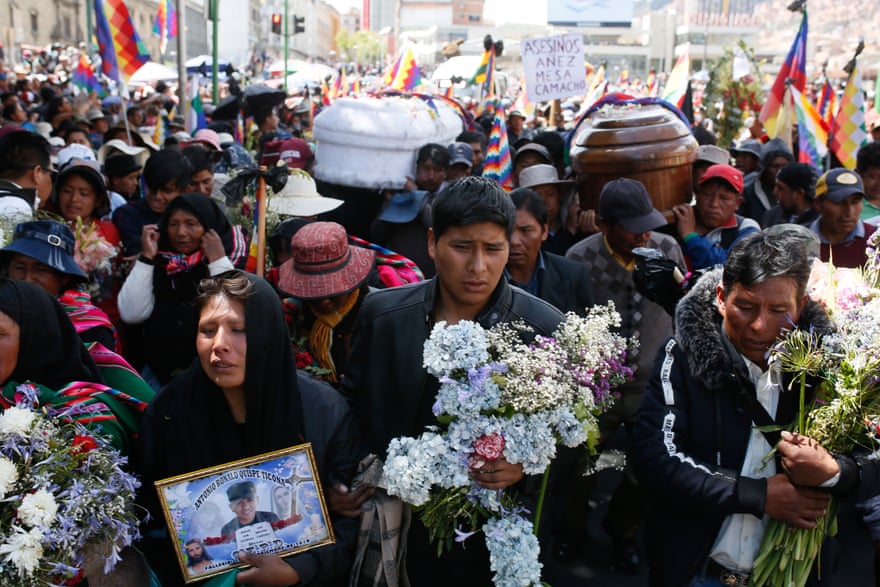
This funeral for eight victims in the capital, La Paz, turned into an anti-government demonstration and was also attacked by riot police. In the turmoil, the coffins had to be abandoned in the street.
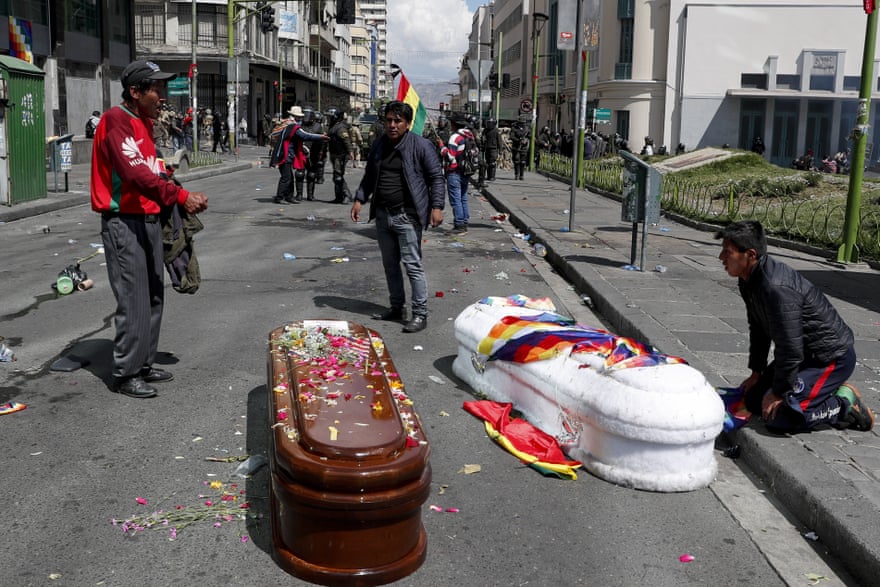
With Morales gone, Christian right-wingers have set about reversing the tide on thirteen years of wealth redistribution, bashing the people who benefited most from it, with truncheons and with the bible, like reborn conquistadors. One indigenous demonstrator was actually heard yelling at a policeman to go back to Spain.
A makeshift replacement for Morales has come in the form of Jeanine Añez Chávez, who declared herself interim president while holding up a large bible. The good book has rarely been so gleefully accessorised. Next to her stood Luis Fernando Camacho, a member of the Christian far-right. After Morales’s resignation, Camacho stormed the presidential palace, a flag in one hand and a bible in the other, while a pastor by his side announced “The bible is returning to the government palace. Pachamama will never return. Today Christ is returning to the Government Palace. Bolivia is for Christ.”
This was an attempt to unravel Bolivia’s pluri-national model according to which the Wiphala (the indigenous flag) was flown next to the tricolour, and no less than thirty-six languages became official national languages alongside Spanish. Since the coup, the police have been spotted ripping the Wiphala off their uniforms. The flag has been burnt in the streets.
The interim president is, predictably, of the same mind as Camacho. In 2013, while still an opposition senator, she tweeted that she dreamt of a Bolivia ‘free of satanic indigenous rites.’ It’s the kind of language Mr Neumeyr would understand. ‘The city is not for the Indians,’ she added. The term ‘Indians’ is itself a disrespectful archaism. Unsurprisingly, the ‘Indians’ displayed a similarly low opinion of her.
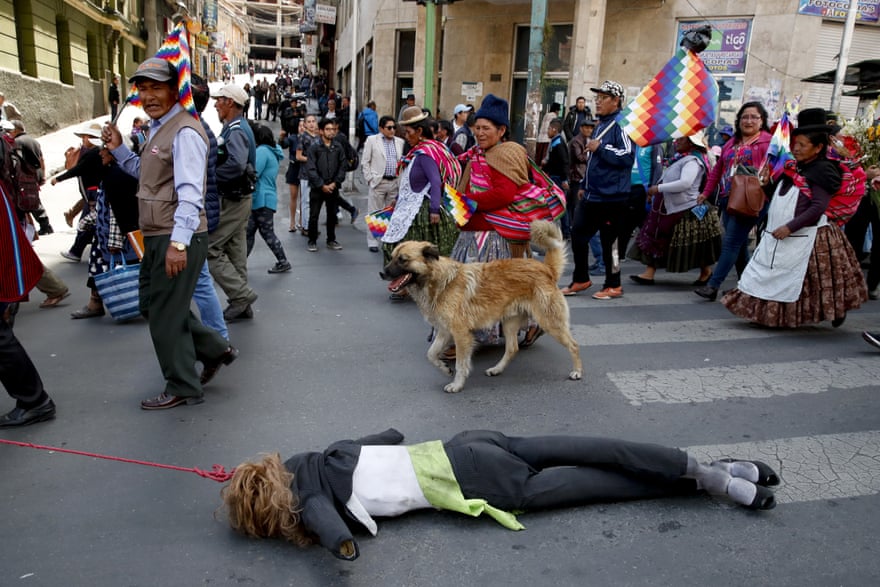
The whole reactionary playbook has more than a whiff of the Vox movement in southern Spain, singing Franco era anthems and openly talking of reconquest at the bull fights. Spanish and Portuguese-speaking parts of the world are shadowing the English-speaking parts in a surge of racial paranoia and atavism. Bolivia, like Brazil, is the scene of a backlash against the very people who lived in these lands before the Europeans first made it over, by accident, in the shape of the world-historically jammy Christopher Columbus. The right and left of the political spectrum have resolved into a stand-off between the inheritors of Spanish conquest – the ones ostentatiously waving the bible around – and the ‘heathen’ natives.
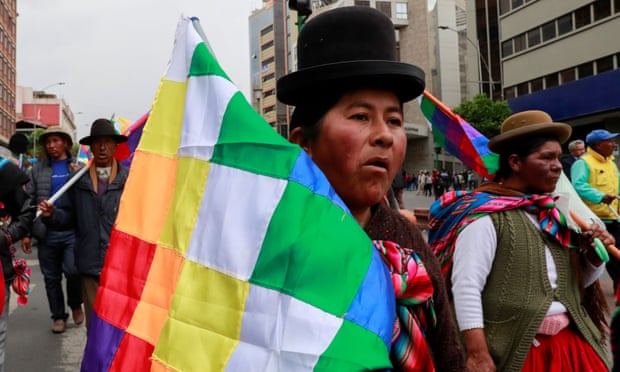
In a way, none of this is surprising. Most of the support for Morales and his Movement Towards Socialism came initially from the Aymara. These are the people whose ‘cholitas’ wear bowler hats and billowing skirts. In the past, these women were shunned by city dwellers like Jeanine Áñez. They were even prevented from using public transport or sitting in restaurants, and the word ‘cholita’ was used as an insult, a state of affairs Áñez would gladly return to.

But the world has moved on, not least through the work of Eliana Paco Paredes, who has made the traditional costume of las cholitas chic. In 2016, she took her designs to the New York Fashion Week where twelve international models presented a collection entitled – you guessed it – Pachamama. When this look reached the runway, the result was pretty spectacular:

Fourteen years ago, my best mate and I arrived in Bolivia just in time for the beginning of Evo Morales’ presidency. All round the Peruvian side of Lake Titicaca it had rained incessantly. It was so cold and wet we listened to the Smiths to cheer ourselves up. Each humdrum town, despondent in the deluge, made us fear that Bolivia would turn out even worse. Then, as we arrived in a place promisingly named Copacabana, the weather suddenly improved.
There’s a Bolivian joke that they got the Titi part of the lake, and the Peruvians got the caca. Taking the little boat out to the Isla del Sol, it was like a prophecy fulfilled. The sun was scorching. As we wandered along the sunlit ridge of the island, we watched as the Peruvians continued to get rained on in the distance. These conditions persisted for days; it was enough to make you admire the meteorological intuition of the Incas who had named that place. The lake was turquoise, deep as any sea. To the east, the horizon was lined with snow-capped mountains. There were no vehicles. Across the terraced fields trudged goats and the occasional goatherd. Women in bowler hats and big dresses ambled along the footpaths. It seemed like the simplest, most beautiful spot in all of Latin America, and we were the only tourists. I remember wondering why there were no rich mansions, just hovels. Surely Elon Musk will have bought the entire island by now, if only to be closer to his lithium.
Immediately after leaving the island and traveling into the Bolivian heartland, we started to see them: big signs, black letters painted on every available wall, shouting EVO. Being a naive tourist from the land of the gringos, I assumed it was some kind of product they were advertising. I had no idea it was the name of an obscure coca farmer who had just become, that very month, the first ever indigenous leader of the country they’d named after Simón Bolívar, the man who’d liberated them from the Spaniards. When we reached a crossroads, we found people in traditional dress playing music and dancing. At the time, I assumed this was the kind of thing people did round here. Only now does it occur to me that they were celebrating Evo’s election. Soon after that – though I can’t find a single piece of photographic evidence – the former coca farmer would present a portrait of Bolívar to the leader of the Venezuelan revolution. The portrait would be made out of coca leaves.
“Struggle, struggle, struggle, struggle. That is where I come from,” says Morales from his present place of banishment. He complains that his only sin was being “indigenous, leftist and anti-imperialist” and that the environmentalists are “the best tools” of that imperialism.
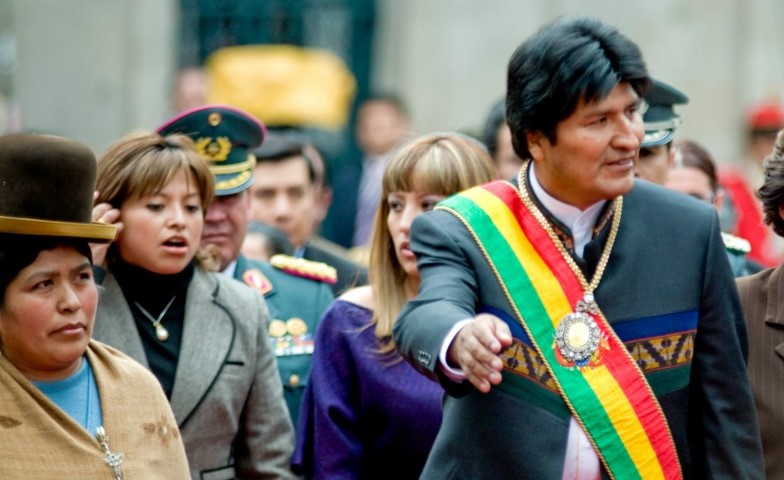
Ah yes, what tools, those environmentalists. And yet why, one might ask, is the great indigenous champion of Mother Earth – the man whose administration liked her so much, they named a ministry after her – complaining about environmentalists?
There are times when Montaigne’s scepticism is a tough example to follow, and this is one of those times, for even as one watches the right in Bolivia crow over the defeat and exile of the indigenous leader, it’s just possible that they have, however inadvertently, done Pachamama a big favour. They have ousted her mortal enemy.
Horrendous forest fires have devastated the country because of a change made to the law by the exiled president. Supreme Decree 3973 was signed in July. Within weeks, the slash and burn method of clearing forests, which it made provision for, had led to huge destruction of complex ecosystems, much of it documented by Dan Collyns in the Guardian. The descriptions of what firefighters witnessed are harrowing:
‘The unprecedented destruction of wildlife was hard to stomach. Even following strict safety protocols, the men struggled psychologically, Manacá’s fire chief, Luis Andrés Roca, said. “The stench of burned flesh was unbearable. It’s nesting season and when the trees caught light the parrots died in their nests. My companions and I would cry, we felt so powerless. It’s the worst tragedy we’ve ever seen here.”
A female firefighter concurred:
“What we’re doing to Bolivia and the Amazon is something that can’t be fixed even if we put out the fire now,” said Olivia Mansilla, an architect who took time off her job in Santa Cruz to volunteer. “What comes next will be a holocaust for nature” (Guardian, 2 September 2019).
But perhaps the most damning criticism came from the pan-Amazon indigenous organisation, COICA, which accused Morales, and his Brazilian counterpart, Jair Bolsonaro, of “gutting every environmental and social strategy to strengthen environmental governance of the Amazon”. These days, if you’re a self-respecting indigenous socialist, you really don’t want to be compared to Bolsonaro. The COICA went on to declare the two governments not welcome in the Amazon and held them personally accountable for the “cultural and environmental genocide” in the world’s largest wilderness.
This kind of thing might lead any sceptic to enquire what constituency the government had been trying to appeal to with its decree. Obviously not the one made up of ‘bugs and insects,’ nor of possibly five hundred rare jaguars. It is estimated that some 4,000 plant species and 1,600 animal species were affected by the fires, and that between 2 million and 18 million wild animals have been killed.
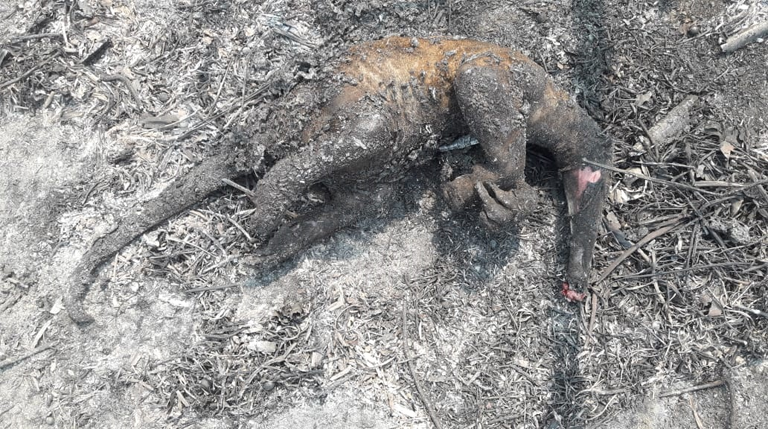
I won’t recite the grim statistics. Suffice to say, it is thought that swaths of forest covering an area larger than Costa Rica were consumed by the flames.
It appears the decree was aimed at fulfilling government pledges to triple the agricultural area and export beef to China, according to Claire Wordley (Desdemona Despair, 1 October 2019). Bolivia’s agricultural industry defended the legalisation, begging the president not to “kill the goose that lays the golden eggs.” As a result, the country’s entire population of golden geese were saved.
Ordinary Bolivians could see the real consequences of all this. Tensions ran high when protesters interrupted an event marking Bolivia’s first beef export to China in San Ignacio. Local media reported that, as Morales sealed the first container of 96 tonnes of beef, the demonstrators chanted: “Behind every fallen tree there’s a laughing cattle rancher.” It remains to be seen if the new regime will be any more inclined to dampen the ranchers’ spirits.
Meantime, the president who brought about this natural disaster is languishing in Argentina somewhere. Surely, given the way he has beaten up Pachamama, he will be lying low and hoping she doesn’t contrive to punish him, perhaps with a personalised tornado, or a bespoke bolt of lightning from on high. At the very least, he must be thinking “It’s a fair cop, I overstayed my welcome.”
Apparently not. In a recent interview, Evo complained about his treatment and defended his attempts to stay on beyond a third term thus: “whereas before I was planning to leave after five more years in government, now, after everything they have done to me, it’s possible I seek the candidacy after that.”
Perhaps he’s missing his brand-new palace, the towering Casa Grande del Pueblo, which he built at a cost of $34 million to replace the Palacio Quemado (Burnt Palace) – not another of Evo’s victims, despite its name. The old palace has been turned into a museum for being too ‘colonial’.
Its replacement, a 29-storey skyscraper in the middle of the historic quarter of La Paz, was opposed by the municipality as being in breach of height restrictions, but the government overruled the decision. It features a helipad, and the top two floors – which are reserved for the president – contain a gym, a spa and a jacuzzi. The bedroom alone is reported to be the same size as the average home provided by his government housing project. This conspicuous luxury led his neoliberal imperialist enemies to complain that Evo was ‘acting more like an emperor than a president.’
What a delicious irony! The building is decorated with indigenous motifs, for crying out loud. It was supposed to be used for indigenous ceremonies. These sceptics were just displaying the kind of bad faith anti-imperialists always have to contend with.









